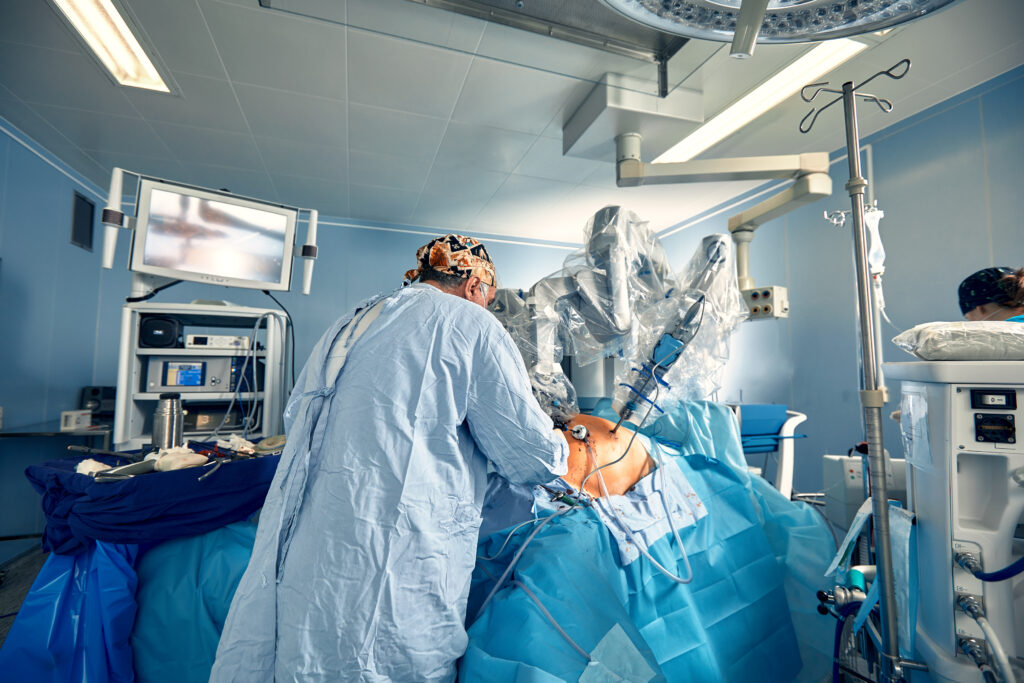Introduction
Is robotic surgery better than traditional surgery? This question is central to ongoing discussions in healthcare, with significant implications for patient care, costs, and the future of surgery. In this article, we’ll look at the key differences between robotic and traditional surgeries, review case studies, and explore which method works best for different types of procedures.
The Problem: Traditional Surgery’s Limitations
Traditional Surgery’s Limitations Open surgery, also referred to as traditional or open surgery, has long been used as part of medical treatments for various medical procedures. Surgeons use open surgery techniques by making large incisions manually in the target area in order to access it using their skill and experience during operations. While traditional surgery has proven its worth in numerous instances, its limitations cannot be overlooked.
Larger Incisions and Longer Recovery:
Traditional surgery involves large cuts, leading to more trauma, longer recovery times, and a higher risk of complications like infections and hernias, especially in procedures like abdominal surgeries.
Human Limitations in Precision:
- Surgeons, while skilled, are subject to natural limitations like hand tremors and fatigue, which can impact precision in complex surgeries like heart and neurosurgery.
Since my career began in surgery, I’ve witnessed firsthand its transformation, from manual procedures to robotic-assisted surgeries and technological innovation in operating rooms. Working alongside surgeons has afforded me unique access to witness this trend first-hand.
Higher Risk of Complications:
- Traditional surgery’s longer duration and larger wounds increase bleeding, infections, and damage to nearby tissues.
What are the risks of robotic surgery?
Robotic surgery, while offering many benefits, also comes with its own set of risks. Here are some of the potential risks associated with robotic surgery:
General Surgical Risks
- Anesthesia RisKs: Breathing problems, and pneumonia.
- Infection: Despite smaller incisions, there is still a risk of infection at the surgical site.
- Bleeding: There can be bleeding during or after the surgery, which may require a blood transfusion.
Specific Risks of Robotic Surgery
- Mechanical Failure: Robotic systems are complex and can experience mechanical failures or malfunctions. Although rare, these issues can disrupt the surgery and may require conversion to traditional open surgery1.
- Human Error: The success of robotic surgery heavily depends on the surgeon’s skill and experience. Inexperienced surgeons may make errors in operating the robotic system, potentially leading to complications.
- Nerve Damage: There is a risk of nerve damage due to the precision required in robotic surgery. This can result in temporary or permanent loss of function in the affected area.
- Electrical Arcing: This is a rare but possible risk where electrical currents used in the robotic instruments can cause unintended burns or injuries.
- Conversion to Open Surgery: In some cases, complications during robotic surgery may necessitate a switch to traditional open surgery, which can increase the risk of infection and prolong recovery time.
As part of my healthcare career, I’ve witnessed surgeries where robots performed delicate tasks that would be challenging even for experienced surgeons to accomplish manually. These experiences gave me an appreciation of technology’s role in healthcare delivery systems.
Unique Risks
- Data Connection Issues: In robotic telesurgery, where the surgeon operates from a distance, the quality of the data connection between the surgeon’s console and the robotic system is crucial. Any disruption can pose significant risks.
- Credentialing and Training: Proper training and credentialing are essential for surgeons performing robotic surgery. Inadequate training can lead to increased risks and complications.
While robotic surgery offers many advantages, it’s important for patients to discuss these potential risks with their healthcare providers to make an informed decision. Each patient’s situation is unique, and the choice of surgical method should be tailored to their specific needs and the surgeon’s expertise.
What are the success rates of robotic surgery?
Robotic surgery generally boasts high success rates, often ranging from 94% to 100% depending on the type of procedure and the patient’s overall health1. Here are some specific examples:
General Success Rates
- Overall Success: Robotic-assisted surgeries have an overall success rate of 94% to 100%.
- Minimally Invasive Procedures: These procedures, which include many robotic surgeries, typically have high success rates due to reduced complications and quicker recovery times1.
Specific Procedures
- Prostate Cancer Surgery: Robotic-assisted laparoscopic prostatectomy (RALP) has shown high success rates in terms of cancer control, with additional benefits like reduced blood loss and quicker recovery.
- Hysterectomy: Robotic-assisted hysterectomies have high success rates, with patients experiencing less postoperative pain and shorter hospital stays compared to traditional methods.
- Cardiac Surgery: Robotic-assisted coronary artery bypass grafting (CABG) has demonstrated fewer complications and quicker recovery times, contributing to its high success rate.
- Colorectal Surgery: Robotic-assisted colorectal surgeries have lower incidences of postoperative infections and quicker return to normal bowel function.
- Bariatric Surgery: Robotic-assisted gastric bypass surgeries have shown high success rates with shorter hospital stays and quicker recovery.
Factors Influencing Success Rates
- Surgeon’s Experience: The skill and experience of the surgeon play a crucial role in the success of robotic surgeries.
- Patient’s Health: The overall health and specific conditions of the patient can impact the success rate of the surgery.
- Type of Procedure: Different types of surgeries have varying success rates based on complexity and the specific benefits of robotic assistance1.
Overall, robotic surgery offers promising outcomes across various medical fields, contributing to its growing popularity and adoption in modern surgical practices.
What are the long-term outcomes of robotic surgery?
Precision and Accuracy:
- Robotic surgery improves precision, especially in prostate cancer, preserving urinary and sexual function.
Case Study: RALP shows better cancer control and outcomes than traditional surgery.
Fewer Complications:
- Robotic surgery reduces infection, blood loss, and pain, leading to faster recovery.
Case Study: Robotic-assisted colorectal surgeries show fewer infections and quicker recovery.
Faster Recovery:
- Patients recover quicker, improving their return to daily life.
Case Study: Robotic CABG results in shorter hospital stays and faster recovery.
Better Cancer Outcomes:
- Robotic cancer surgeries provide better or equal long-term survival.
Case Study: Robotic colorectal surgeries show improved cancer control.
Improved Functional Outcomes:
- Robotic surgery enhances urinary and sexual function.
Case Study: RALP offers better nerve preservation and post-surgery function.
High Satisfaction:
- Patients prefer robotic surgery due to less pain and quicker recovery.
Case Study: Robotic surgeries consistently report higher patient satisfaction.
Agitation: The Need for Better Surgical Precision and Patient Outcomes
Need for Precision and Better Outcomes:
- Traditional surgery often lacks precision and causes more discomfort during recovery time and complications; thus necessitating alternative techniques.
Rise of Minimally Invasive Methods:
- There is an increasing demand for minimally invasive surgery methods that minimize discomfort, reduce recovery times and enhance overall success rates.
Robotic Surgery as a Solution:
- Robotic systems such as Da Vinci offer superior accuracy and minimal invasiveness compared to traditional surgery techniques, filling any precision gaps left by traditional procedures.
Challenges of Traditional Surgery:
- Traditional methods may result in significant blood loss, longer hospital stays, higher infection risks and longer recovery periods for a patient thus compromising daily life. Comparing Robotic Surgery With Conventional.
Comparing Robotic and Traditional Surgery:
- Robotic surgery could present an effective way out, yet it’s essential that case studies and data be scrutinized carefully in order to gauge its performance against traditional surgery techniques.
Final Evaluation:
- At its heart lies the question of whether robotic surgery consistently outperforms traditional approaches; to answer this properly requires extensive analysis.
Solution: A Closer Look at Robotic Surgery
Robotic surgery is a type of minimally invasive surgery that utilizes robotic arms controlled by a surgeon from a console. Through a small incision, the robotic arms manipulate surgical instruments, while a camera provides a 3D high-definition view of the inside of the patient’s body. The surgeon remains in control at all times, directing the robot’s movements.
Precision and Accuracy:
- Robotic surgery allows for precise movements, reducing damage to surrounding tissues. In prostate cancer surgery, robotic systems help extract cancerous tissue while preserving nerve function. Research in Journal of Urology shows robotic-assisted surgeries result in less blood loss, faster recovery, and better preservation of urinary and sexual function.
Reduced Invasiveness:
- Robotic surgery requires smaller incisions, leading to less pain, minimal scarring, and quicker recovery. A study in American Journal of Obstetrics and Gynecology highlights reduced postoperative discomfort and superior cosmetic outcomes in robotic-assisted hysterectomies compared to traditional methods.
Enhanced Visualization:
- Robotic systems provide surgeons with high-definition 3D views, improving precision in complex procedures like heart surgeries. A study in Annals of Thoracic Surgery found robotic-assisted coronary bypass surgeries had fewer complications and quicker recovery than traditional methods.
Reduced Risk of Infection:
- Smaller incisions and reduced tissue manipulation lower infection risks, particularly in surgeries like colorectal procedures. Research in Journal of Gastrointestinal Surgery shows robotic-assisted surgeries resulted in fewer infections and quicker return of bowel function compared to traditional surgery.
Is Robotic Surgery Always the Better Option?
Robotic Surgery Overview:
- Robotic surgery uses robotic arms controlled by the surgeon through small incisions, offering high-definition 3D views. The surgeon remains in full control of the robot at all times.
Experience with robotic surgery began when I joined a team that specializes in minimally invasive procedures. The precision offered by robotic systems immediately caught my attention as I saw better outcomes for patients using them.
Learning Curve for Surgeons:
- Surgeons require specialized training to effectively use robotic systems. Outcomes improve over time as surgeons gain experience, as demonstrated by Stanford University research.
Higher Costs:
- Robotic surgery systems are expensive to purchase and maintain, leading to higher patient costs. However, long-term savings may result from shorter hospital stays and fewer complications, as shown by Health Affairs studies.
Not Suitable for All Procedures:
- Robotic surgery is ideal for specific tasks but may not be needed for routine procedures, where traditional methods remain effective and cost-efficient
How do patients decide between the two methods?
Type of Surgery:
- Robotic preferred for complex procedures and traditional for emergencies due to quicker setup.
Surgeon’s Recommendation:
- Expertise and success rates shared by the surgeon play a crucial role.
Patient’s Health Condition:
- Robotic surgery benefits those with specific health needs; scar tissue from past surgeries may affect the choice.
Recovery Time:
- Robotic surgery often offers quicker recovery, ideal for those needing a faster return to daily activities.
Cost and Insurance Coverage:
- Robotic surgery may be more expensive; insurance coverage can influence the choice.
Hospital Facilities:
- Not all hospitals offer robotic surgery, and hospital reputation for success can affect decisions.
Personal Preferences:
- Comfort with technology or traditional methods, along with personal research, can guide the choice
Case Studies and Testimonials
- Real-Life Experiences: Hearing from other patients who have undergone either type of surgery can provide practical insights and help in making an informed decision.
However, robotic surgery also presents certain challenges, including equipment malfunction and high costs – experiences which remind me that while robotic surgery offers promise it does have limitations.
What are the common misconceptions about robotic surgery?
- Robot Performs the Surgery: A surgeon controls and directs the robot during surgery. It does not operate automatically.
- Robotic Surgery is Risk-Free: Robotic surgery does present some risks; however they tend to be lower when compared with traditional surgeries.
- Robotic Surgery is Always Better: Robotic surgery may not always be superior but in certain instances traditional surgeries might be preferable.
- Robotic Surgery is Pain-Free: While patients may still experience some level of discomfort during recovery from robotic surgery procedures, usually less so than traditional ones.
- All Surgeons are Equally Skilled: Surgeons require extensive specialized training, and their expertise can greatly influence outcomes.
- Robotic Surgery is Completely New: Robotic surgery is only appropriate for certain procedures.Though robotic surgery has only recently entered mainstream clinical care, its studies and history are extensive and well documented.
- It is Only for Certain Procedures: Robotic surgery has found use across various fields such as urology, gynecology and cardiothoracic surgery.
- Robotic Surgery is Unaffordable: While costly, insurance often covers it and faster recovery could outweigh costs.

Surgical system with minimally invasive robot in a hospital. Robotic technological equipment, manipulator surgeon in a futuristic operating room. Medical innovation 3D endoscopy for robotic surgery in healthcare and sarcoma surgery.
Conclusion: Is Robotic Surgery Better? It Depends on the Case
Robotic surgery offers benefits like increased precision, faster recovery, and reduced risks, making it suitable for complex procedures. However, it is costly and requires specialized training. Traditional surgery may be preferable in certain cases due to its reliability, lower costs, and surgeon familiarity. The decision between robotic and traditional methods depends on the patient’s needs, the complexity of the procedure, and the surgeon’s expertise.
Call to Action: Making Informed Surgical Choices
Consult with your surgeon to understand the risks and benefits of both methods and choose the best approach for your situation.
FAQS
1.What is robotic surgery?
Robotic surgery is a surgery done with the help of robots for better precision.
2.How does robotic surgery differ from traditional surgery?
Robotic surgery offers enhanced precision, while traditional surgery relies on manual techniques.
3.What are the benefits of robotic surgery?
Robotic surgery provides improved accuracy, smaller incisions, and faster recovery.
4.Are there risks involved with robotic surgery?
Yes, robotic surgery carries risks such as technical malfunctions and limited surgeon experience.
5.Is robotic surgery more expensive than traditional surgery?
Robotic surgery is typically more costly due to advanced technology.
6.Can robotic surgery treat all medical conditions?
Not all conditions are suitable for robotic surgery; it depends on the procedure and patient needs.
7.How experienced are surgeons in performing robotic surgery?
Surgeon experience varies, as robotic surgery requires specialized training.
8.Does robotic surgery reduce recovery time?
Yes, many patients experience shorter recovery times with robotic surgery.
9.Are there any long-term effects of robotic surgery?
Most patients recover well, but long-term effects depend on the procedure and individual health.
10.Is robotic surgery safer than traditional surgery?
Both have safety measures, but robotic surgery can reduce human error in certain procedures.

